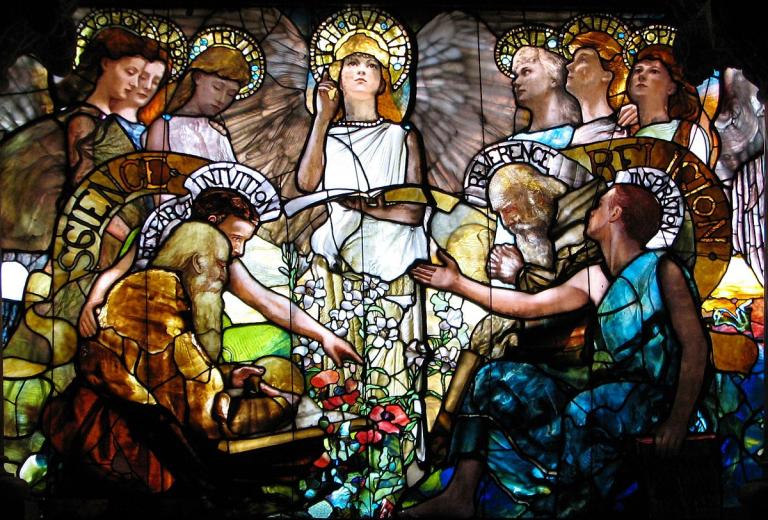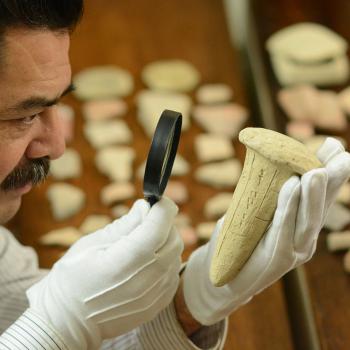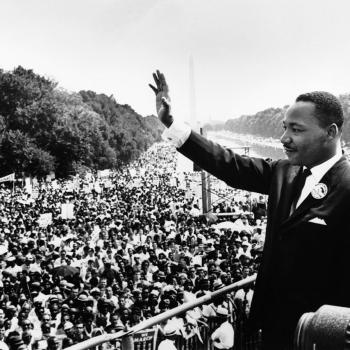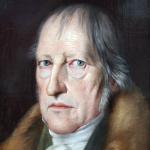
The following is an interview with S. Joshua Swamidass, M.D., Ph.D. of Washington University in St. Louis, Missouri. Dr. Swamidass is the founding scientist of the new organization “Peaceful Science.” Its motto is, “A civic practice of science, making space for differences.” You may know Dr. Swamidass from the two articles for Cultural Encounters he authored, one on Narnians, Martians and Neanderthals and another on Jesus and evolution. I first met Dr. Swamidass when he spoke at the New Wine, New Wineskins conference I oversaw titled “Church and Science: Partners for the Common Good.” The conference was part of the Science for Seminaries grant initiative New Wine, New Wineskins coordinated for Multnomah Biblical Seminary (MBS). MBS was one of ten seminaries in the AAAS Science for Seminaries pilot program. In addition to my ongoing work in an advisory capacity for various seminaries in the Science for Seminaries program, I now serve as an advisor at Peaceful Science.
Paul Louis Metzger (PLM): Josh, as I noted above, you have founded an organization titled “Peaceful Science.” In our society, unfortunately all too often, people do not perceive science to be peaceful or as a cause for human flourishing. I wish to begin with asking three related questions. In your estimation, why is that perception of science so prevalent? Now given that prevailing perception in many quarters, why do you call this new organization “Peaceful Science”? What led you to form Peaceful Science?
S. Joshua Swamidass (SJS): Science is often surrounded by conflict, especially on questions of origins. While science and scientists carry authority in society, people sometimes feel that scientific authority is abused, especially when our questions are not received with empathy. Maybe the conflict is not inevitable.
I chose the name Peaceful Science because I wanted to seek peace in a place of conflict. Rather than being a club for an elite few or a weapon used for or against people groups and political agendas, science is meant to welcome all to explore life’s grand questions together. Scientists, at our best, receive questions with courage, curiosity, and empathy. This dialogue-based and trust-building conversation is where we at Peaceful Science are focused.
Perhaps as we make space for our differences, we can find a better way forward together. Peaceful Science is aimed at that peacemaking effort, a civic practice of science. Our practice is motivated by values endorsed by scientists from diverse backgrounds, from Christian to atheist, and our approach is consistent with the AAAS guidelines on engaging the public.
Peacemaking is central to my calling as a scientist in the Church and as a Christian in science. I was raised a young earth creationist, so mainstream science was a place of conflict for me. I’ve seen so many others stuck in this conflict too, especially students and seekers in science. In light of my empathy for their paths, Peaceful Science was formed.
PLM: Frequently, people in our society believe that where science advances, faith retreats. They often espouse some form of the “Draper-White Conflict Thesis.” What is your take on this Conflict Thesis historiography, and how does Peaceful Science address this conflict?
SJS: The Conflict Thesis is a widely debunked theory purporting that the Christian faith and science are locked in inevitable conflict. The real story is more complex. There are examples of conflict, but also of collaboration. Some historians even link Christian distinctives with the rise of science.
While the Conflict Thesis has been debunked, conflict, nonetheless, remains quite common, especially surrounding human origins. Charles Darwin first published On the Origin of Species in 1859, without mentioning human origins. Thomas Henry Huxley rushed in where Darwin did not tread, arguing that humans evolved from common ancestors with the great apes. It seems obvious to many that if evolution is true, then the Genesis account of Adam and Eve has to be false. This perceived conflict between Genesis and evolution underlies much anxiety.
Here, in this area of conflict, is one place that Peaceful Science seeks peace by taking a closer look at the science. In my book The Genealogical Adam and Eve, I found that much of this conflict is an illusion, arising from a misunderstanding of science. Entirely consistent with the evidence, Adam and Eve, ancestors of us all, could have been de novo created, as recently as 6,000 years ago. The only way evolution presses on this story is by suggesting, alongside Scripture, that there were people outside the Garden that eventually interbred with Adam and Eve’s lineage.
Of course, some of us think evolution is a myth. Some think that the story of Adam and Eve is a myth. Either way, this opens up a new conceptual space, a new story, where we can explore larger questions together.
Will this end all the conflict? Of course not. It does, however, open up new ways to find peace. Making space for differences in this way is good for science, society, and the Church.
PLM: One of the striking aspects of your personal trajectory on faith and science is that you take very seriously the bodily resurrection of Jesus Christ from the dead. Could you please share how Jesus’ resurrection bears upon your paradigm for faith and science’s constructive interaction?
SJS: My personal journey through science is a search for a confident faith.
I was raised in a Young Earth Creationist household. My mother talked to toddler me about Jesus, and I believed. As a middle schooler, I read More Than a Carpenter, and came to see clearly the truth of the resurrection. At the empty tomb, my faith became my own.
As a student, I was drawn to science, but as my scientific knowledge grew so did my doubts. Searching for confidence, I turned to anti-evolution arguments of various sorts. At the time, these arguments were comforting, but they drew me away from Jesus. I had become like Peter in the garden when the soldiers came to arrest Jesus (Matthew 26:47-56). Jesus seemed like a powerless bystander, in need of my defense, irrelevant to the debate. Still like Peter, I was threatened all the same.
Scripture testifies to a different Jesus. In losing sight of the One who needs no defense, I struggled for many years with an insecure and threatened faith. Something had to change, and thankfully it did. In time and through grace, I remembered the same Gospel my mother first shared with me. The same gospel that Paul confesses (I Corinthian 15:3-7), and the “one sign” that Jesus gives to skeptics: his death and resurrection (Matthew 12:38-42). I found a different apologetic, offering an explanation (I Peter 3:15), rather than a defense, of the hope growing within me.
I am a scientist now. Science is powerful and grand, full of the beauty and mystery of God’s creation. I have searched all over. Jesus, still, is greater than all I found in science. Whether evolution is true or not, God raised this man Jesus from the dead. This is how I know that God exists, that He is good, and that He wants to be known.
Here, at the empty tomb again, I found a confident faith. I left my anti-evolution idols. I followed Him.
PLM: You welcome constructive conversations and explorations with adherents of theistic evolution, old earth creationism, young earth creationism, and a completely secular or materialistic framework. How are you able to cultivate dialogue involving such diverse groups? How have these diverse forms of interaction and exploration gone so far?
SJS: Science is often conflicted. Origins, in particular, is a quagmire. There has to be a better way forward. We find ourselves in the no man’s land between the trenches. The conflict here has been raging for a long time. Some are skeptical and distrustful. Others are attracted, hoping for that better way. We are finding that people from all sides of the conflict are hoping for a better way.
At Peaceful Science, we want to make space for differences in a civic practice of science, aspiring to humility, tolerance, and patience. In humility, we recognize we cannot convince everyone to agree with us. In tolerance, we want to make space for those with whom we disagree, even as we maintain our own beliefs and practices. In patience, we seek to understand one another and to be understood, even when we disagree.
Humility. Tolerance. Patience. My articulation of these values echoes law professor John Inazu in Confident Pluralism. I work with Prof. Inazu at The Carver Project in Saint Louis, in service of the Church and society, and Peaceful Science is working out these shared values in science.
I am a Christian and I affirm evolutionary science. Peaceful Science, however, includes people with all sorts of beliefs about religion and science. Our online forum can be rowdy at times, but it is also inviting. It is our front porch. Personally, I want to alter the pattern between Christians and atheist scientists. Sometimes Christians forget. The atheist is our neighbor, even if of the anti-religious sort. We are moving towards seeing others as fellow citizens of society, more connected to each other than we expect.
In our civic practice, we’ve seen surprising things.
A public Christian scientist, Darrel Falk, who had argued against Adam and Eve for a decade, admitted he was “wrong.” A public atheist scientist, Nathan Lents, articulated a thoughtful affirmation of original sin, publicly supporting my work on Adam and Eve in a USA Today article and on NPR. A Christian College chemistry professor, Jordan Mantha, explained a perspective altering encounter with a homosexual atheist Christian. Another atheist scientist faced a humanist dilemma in my book, deciding to endorse it as a moral imperative, against his own desires. A physics PhD student, just published in Nature, explained why he believes Jesus rose physically from the dead to a group of secular scientists. Together, we are taking seriously all sorts of questions from the public. We are understanding each other in new ways, ways that are changing us.
Community across differences is messy and unpredictable, especially in the internet age. Our forum is not for everyone. Still, the exchange is always more fun, the dialogue is more authentic, when you don’t know what to expect. Opening up a larger conversation, we recently started a Facebook group for my book for Peaceful Science as a whole. We are finding something real and valuable here.
PLM: Along these same lines, you and I have talked about ‘centered versus bounded set’ models of interaction and the need for dialogue over monologue on faith and science explorations. Could you please explain how Peaceful Science models a centered set and dialogical approach to faith and science inquiry?
SJS: In a bounded approach, I had always heard that the origins debate could be divided up into three or four monolithic “camps.” All of the interesting questions, it seemed, were ironed out so that one had to choose between these camps. The internal conversations were hidden away, and so were the opportunities for common ground and rapprochement. The appeal of the bounded approach is that it binds up complexity into neat packages and stories. The danger is that this approach perpetuates the conflict, repeating parallel monologues in place of a true dialogue where we could make progress together.
Peaceful Science takes a centered approach, much as you do with New Wine, New Wineskins. We center around shared values and questions, but we encourage freedom and value diversity beyond these touch points. This creates space for dynamic and unscripted exchanges, where minority views are understood, questions are taken seriously, and even our own views might be changed. In this place of true dialogue, we might be genuinely surprised by what we find.
For example, I was surprised to learn of Young Life Creationists (YLC), a branch of Young Earth Creationists (YEC). These are Christians who agree that the universe and the earth are old, but they believe that all life on earth was created in the last 10,000 years. My book extends YLC logic a little farther, offering a Young Adam Creationist (YAC) position that is entirely consistent with mainstream science.
Likewise, I was surprised to meet atheist scientists that genuinely cared about the Genesis creation account. They were even opinionated about how to interpret stories about Adam and Eve. Many were people of peace, who supported and advised me as I engaged questions in the Church.
Allowing people to stray from the strict roles they’ve been assigned creates space for genuine thought and reflection. Over and over, opportunities for common ground arise. We find people of peace in unexpected places. We find community across our disagreements.
PLM: Josh, please share with us about the mission of Peaceful Science and what you envision this new enterprise will do in the next few years.
SJS: Peaceful Science’s mission is to advance a civic practice of science by seeking dialogue in discord and understanding across disagreements. We hope to do this by fostering interdisciplinary scholarship engaged with science and the public, and by encouraging conversation around a grand question: what does it mean to be human?
So far, most of our contributions have been on the topic of human origins. That will continue. I’m writing a book now with William Lane Craig on Adam and Eve. In addition, this January 18th, Peaceful Science is hosting a workshop with Reasons to Believe on human origins (watch the livestream). Ironically, I am not even a scientist in this precise area. Against my expectations, I was captured by the questions here. I was lucky enough to advance our understanding, noticing some things in the science of ancestry that others overlooked.
In the next few years, however, we are expanding beyond origins into other areas, other angles on the grand question. Most of my professional work as a scientist is in artificial intelligence (AI). Many of the same questions of theological anthropology arise here, too. Could AI ever be made in the image of God? Could AI have a mind? What do we make of all the ethical questions surrounding AI? These sorts of questions are of growing interest to a lot of people, including me.
We are also exploring the exchange between art and science. Art presses into questions, engaging their complexity without fear, much in the same way that good science does. It seems that if we want to touch on that grand question, of what it means to be human, art needs to play a role, too.
PLM: Where can people find out more, and how can they get involved? What closing thoughts do you wish to share with our readers?
SJS: You can learn more about Peaceful Science by reading our blog and joining our mailing list to stay in the loop on upcoming events. Like our facebook page and join the facebook group, too.
As for closing thoughts, I would like to invite others to join the conversation at Peaceful Science. Science is often conflicted. Origins, in particular, can seem like a quagmire. It doesn’t have to be this way, though. The exchange ahead is dynamic. I don’t know quite were things will lead. Help us find a better way forward together.
















